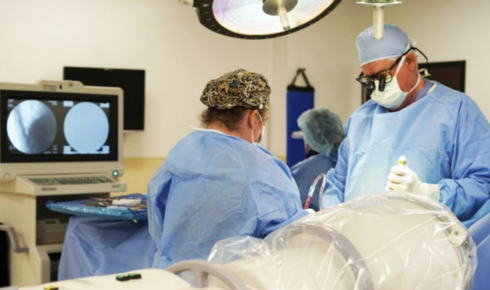
Most people feel some degree of stiffness or fatigue after a long day of sitting. But when these sensations begin to appear more often, or linger long after standing up, they may be signaling something more than poor posture. Dr. Larry Davidson, a leader in spinal surgery, encourages older adults to take these early warnings seriously. What feels like a minor annoyance could point to a deeper structural issue that benefits from early care.
The spine is designed to move. When discomfort becomes a regular part of everyday life, whether during meals, car rides or while reading, it’s time to look more closely. Recognizing the difference between everyday strain and the early signs of a spinal condition can make the difference between simple intervention and complex treatment later.
When Normal Discomfort Crosses a Line
Sitting-related fatigue is common, especially after long periods. But normal discomfort tends to fade once the body begins to move. A short walk, a stretch or a shift in position usually relieves the pressure.
Persistent or recurrent discomfort, on the other hand, may not respond to basic movement. It might appear more quickly, last longer, or begin to radiate beyond the spine. Symptoms that spread to the hips, legs or feet could signal nerve compression, spinal stenosis or disc issues that require medical evaluation.
Postural Fatigue or Structural Strain?
Postural fatigue occurs when muscles tire from holding an unsupported position. Slouching, leaning or sitting in unsupportive chairs can lead to muscle tension and dull aches. While uncomfortable, this fatigue typically improves with posture correction, stretching or basic movement.
Structural strain involves the spine’s deeper components, discs, joints and nerves. This kind of discomfort is more persistent and may come with sensations like tingling, burning or tightness in specific areas. A person might find themselves constantly adjusting in their chair, unable to settle into a comfortable position. In some cases, structural strain can also lead to leg weakness or balance issues after sitting for extended periods. Recognizing these signs early allows for a quicker response. Taking action before problems progress can help prevent chronic pain, degeneration or decreased mobility.
Dr. Larry Davidson highlights that many patients delay care because their pain “didn’t seem bad enough” to warrant attention. But by the time discomfort interferes with daily tasks, the spine may already be compensating for instability or damage. Early intervention, especially physical therapy and movement-based care, often leads to better results, shorter recovery times and fewer long-term complications.
He encourages individuals to document their symptoms over several days, noting when they occur, how they feel and what improves or worsens them. This information helps care teams make accurate assessments and tailor strategies that fit the person’s needs.
Red Flags That Shouldn’t Be Ignored
While not every backache requires urgent care, there are specific symptoms that warrant a professional evaluation:
- Numbness or tingling in the legs, feet or groin
- Shooting pain that travels down one or both legs
- Loss of bladder or bowel control
- Noticeable weakness in the legs or difficulty standing
- Pain that wakes you at night or worsens when lying down
These symptoms may indicate spinal nerve involvement, disc herniation, or more serious spinal instability. Prompt care in these cases is not just helpful. It’s necessary to prevent permanent damage.
Practical First Steps Toward Relief
When sitting discomfort begins to interfere with routine activities, small adjustments can make a meaningful difference. Choosing chairs with proper lumbar support, placing screens at eye level, and taking frequent movement breaks every 30 to 45 minutes are simple ways to relieve pressure.
Gentle exercises that focus on core engagement, hip mobility and posture correction can also help redistribute weight and ease spinal tension. These may include pelvic tilts, seated leg lifts or supported stretches that restore circulation and muscle balance.
If symptoms improve with these changes, it’s a sign that posture and muscle endurance played a significant role. However, if the pain continues or returns soon after resting, it may indicate the need for a more thorough evaluation.
Understanding the Role of Imaging and Assessment
When symptoms are persistent or unclear, providers may recommend imaging such as X-rays, MRI or CT scans. These tools can identify disc height loss, arthritis, spinal narrowing, or other signs of degeneration.
Functional assessments are important. Movement screenings, balance tests and strength evaluations offer insight into how the spine responds to daily demands. This information supports a more complete diagnosis and guides the creation of an effective care plan.
Early assessments don’t always lead to surgery. In many cases, they open the door to conservative options that preserve mobility and reduce discomfort, before more advanced interventions are required.
Personalized Movement Over Prescribed Rest
Old advice once suggested resting for back pain, but newer strategies focus on supported movement. Keeping the spine engaged through safe, low-impact activity helps prevent joint stiffness, muscle atrophy and mood decline. Rest is still important, but so is learning when and how to reintroduce movement in a structured way.
Guided physical therapy, aquatic exercise or chair yoga can help rebuild postural strength and confidence. These approaches also improve circulation and reduce inflammation that may contribute to discomfort. The goal is not to eliminate every sensation, but to prevent discomfort from limiting independence or daily participation.
When to See a Spine Specialist
A primary care provider is often the first stop for spinal concerns. They can assess symptoms, prescribe early interventions and refer patients to physical therapy. If progress stalls or neurological signs appear, a referral to a spine specialist is appropriate.
Spine specialists provide deeper evaluation and a wider range of treatment options. These may include targeted injections, diagnostic procedures or, in some cases, surgery for structural correction.
Seeking care does not commit anyone to invasive treatment. It simply opens the door to information, options and support.
The Value of Listening Early
Back discomfort that starts in a chair doesn’t need to be there. While minor aches may seem manageable, they often reveal patterns in how the spine is functioning or struggling. Early awareness and action lead to better outcomes, fewer setbacks and more confidence in movement.
By learning to recognize when “normal” discomfort becomes something more, older adults can avoid potential issues. Spine health is not just about managing pain. It’s about preserving the freedom to move, connect, and live fully at every stage.



